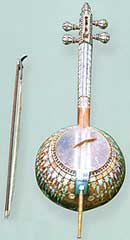|
| Tree-stringed
kamancha
Azerbaijan
History Museum.
The 19th c.
|
The
kamancha is played with a bow. It is widespread amongst
Eastern and Central Asian peoples under a variety
of names. In Azerbaijan, the kamancha reached a high
level of development starting from the second half
of the 19th century. This is closely connected with
the development of the khanande art.
Earlier kamanchas were made of pumpkin and the wood
of nutmeg and decorated with ivory.32 The one-stringed
and two-stringed versions of the kamancha are thought
to be descendents of the gopuz played with a bow.
The kamancha is described in the works of medieval
classical poets. Mir Seyid Ali, representative of
the 16th-century school of painting, depicted the
barbat, daf and kamancha in his work called "A
Musical Gathering".
Abdulgadir Maraghayi mentioned the kamancha in his
works. E. Kaempfer, a German traveler who visited
Azerbaijan in the 17th century, noted that the kamancha
had three or four strings and a fine timbre. Nizami
Ganjavi described the kamancha in his "Khosrov
and Shirin":
The
Kaman is moaning like Moses
And is listening to the singer while he is singing.
The singer started a beautiful gazal
And praised this feast.
 |
|
Kamancha,
decorated with mother-of-pearl
The
State Museum
of Azerbaijani Musical Culture.
The 19th s.
|
In
the 20th century, there were three-stringed, four-stringed
and even five-stringed kamanchas. There is a 1 9th-century
five-stringed kamancha preserved in the ethnography
fund of the Azerbaijan History Museum. The kamancha
that belonged to Zulfugar Hajibeyov, a well-known
Azerbaijani composer, is also exhibited in this Museum.
The body and the neck of this three-stringed kamancha
are tastefully decorated with mother-of-pearl. The
body of the instrument is horizontally cut in the
middle and covered with leather.
The kamancha consists of a head and neck and a spit
that passes through the head and connects the two
parts. The body, head and pegs are hewed out of a
nut tree with thehelp of a special device. The open
front part of the instrument is covered with sturgeon
skin. The sound quality of the instrument depends
on the distance between the neck and strings. The
total length of the instrument is 700 mm. The body
is 175 mm tall and 195 mm wide.
The kamancha's range is from the "la" of
the small octave to the "la" of the third
octave. The scores for the instrument are written
in the "sol" clef (treble clef, or G clef)
and the instrument is played one tone higher. It is
tuned in perfect fourths and fifths.
|